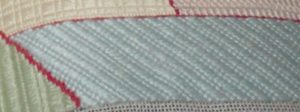
Today we start with the first patch in our Free Needlepoint Stitch Sampler based on oriental crazy quilts.
You might be wondering why Silk & Ivory was chosen for this sampler. It’s because it has a very appealing quality to it, one often called “life” in thread, fabric, and fibers. It refers to the way light plays on the stitched surface. Silk is well-known for its shimmery qualities and for the way it can be dyed into different colors. When you make a thread which is made of two fibers, the thread takes on some of the qualities of each fiber in the blend. Thus with silk/wool you get some of the soft and lush qualities of wool with the life and bright colors of silk.
One way to use this to great advantage in needlepoint is to make a patterns where the stitches go in different directions. The thread reflects light differently depending on the direction of the stitch. This is called directional light (find this blogs articles about it here) and it highlights some of the patches in the sampler.
In others, slight color changes happen because there are stitches of different lengths. Longer stitches always look a bit lighter than shorter stitches; this is one reason why they stand out sometimes.
This week’s patch is in the lower right corner of the outline. It is stitched in Twill Stitch, above. It is made in diagonal rows, one row going over four canvas threads and the shorter rows going over two canvas threads, as you can see in the diagram below.

Begin at either the top or the bottom of the patch somewhere in the middle. I started stitching with a long row, but either row will work. Move in a diagonal row, you can make the slant your choice (I picked upper left to lower right). Once you have completed the first row, make the row next to it one one side. Then continue until you get to the end of the patch. Then complete the rows on the other side.
The Twill Stitch can make an exceptional background when you want to have the direction of the background change in each quadrant of the design, Mark the center of each side at the margins of your canvas. Then work from the outside corner of the background to the center, having the diagonals slant towards the center. Fill the entire quadrant and then change the direction of the slant in the next quadrant, working it from the corner in. Doing a background like this really draws the eye towards the center of the piece.
About Janet M Perry
Janet Perry is the Internet's leading authority on needlepoint. She designs, teaches and writes, getting raves from her fans for her innovative techniques, extensive knowledge and generous teaching style. A leading writer of stitch guides, she blogs here and lives on an island in the northeast corner of the SF Bay with her family

Leave a Reply